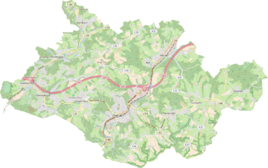Bixnaaf
|
Bixnaaf
City of Overath
Coordinates: 50 ° 56 ′ 15 ″ N , 7 ° 21 ′ 58 ″ E
|
||
|---|---|---|
| Height : | 239 m above sea level NN | |
|
Location of Bixnaaf in Overath |
||
|
View from the Naafbrücke to the Naafbach
|
||
Bixnaaf is a district of Marialinden in the town of Overath in the Rheinisch-Bergisches Kreis in North Rhine-Westphalia , Germany .
Location and description
Bixnaaf is a small district, mainly characterized by wet green areas, south above the Aggertal on the border with the Rhein-Sieg district . The next places are Bixnaafermühle , Hentgesnaaf , Neverdorf (Rhein-Sieg-Kreis) and Schommelsnaaf , which are all connected by the Naafbach . The near-natural, meandering Naafbach rises from a largely underground headwaters and flows into the Agger. The area is part of the Marialinder Riedelland, which is worth protecting . Bixnaaf is located on Landesstraße 360 and is connected to local public transport by the RSV bus line 575 .
history
The brook name Naaf , in the 13th century as de Nafe , in 1555 as the Nave , is a river name word of Indo-European origin, the root of which cannot be traced in German . The meaning seems to be neutral flow and is related to the Greek nao (= flow ), Latin nato (= swimme ) , navis (= ship ).
The Topographia Ducatus Montani by Erich Philipp Ploennies , Blatt Amt Steinbach , shows that the residential area had a courtyard as early as 1715, which is labeled as Bic Naf . Carl Friedrich von Wiebeking names the court Bixnaf on his charter of the Duchy of Berg in 1789 . It shows that the place was part of the Honschaft Oderscheid in the parish of Overath at that time .
The place is recorded on the topographical survey of the Rhineland from 1825 as Bics-Naaf . The Prussian first recording from 1845 shows the residential area under the name Bixnaf . From the Prussian new admission in 1892, the place is regularly recorded as Bixnaaf on measuring table sheets .
In 1822, 30 people lived in the place categorized as farm and mill , which after the collapse of the Napoleonic administration and its replacement belonged to the Overath mayor's office in the Mülheim am Rhein district and was called Bixnofen at that time . Obviously Bixnaafermühle was part of the place at that time. For the year 1830, 36 inhabitants are given for the place called Hof mit Mühle and still called Bixnofen , together with Bixnaafermühle. In 1845, according to the survey of the government district of Cologne, the place called Bixnaf and categorized as Hof und Mühle had eight residential buildings with 36 inhabitants, all of them Catholic faith, together with Bixnaafermühle. The municipality and estate district statistics of the Rhine Province lists Bixnaaf in 1871 alone with nine houses and 44 inhabitants. In the municipality lexicon for the Rhineland province of 1888, nine houses with 38 inhabitants are given for Bixnaaf. In 1895 the place had nine houses with 45 inhabitants and belonged denominationally to the Catholic parish of Marialinden, in 1905 ten houses and 42 inhabitants are given.
Individual evidence
- ^ Heinrich Dittmaier : settlement names and settlement history of the Bergisches Land . In: Journal of the Bergisches Geschichtsverein . tape 74 , parallel edition as a publication by the Institute for Historical Regional Studies of the Rhineland at the University of Bonn. Schmidt, Neustadt ad Aisch 1956.
- ^ Wilhelm Fabricius : Explanations for the Historical Atlas of the Rhine Province ; Second volume: The map of 1789. Division and development of the territories from 1600 to 1794 ; Bonn; 1898
- ↑ Alexander A. Mützell: New topographical-statistical-geographical dictionary of the Prussian state . tape 1 . Karl August Künnel, Halle 1821.
- ↑ Friedrich von Restorff : Topographical-statistical description of the Royal Prussian Rhine Province , Nicolai, Berlin and Stettin 1830
- ↑ Overview of the components and list of all the localities and individually named properties of the government district of Cologne: by districts, mayor's offices and parishes, with information on the number of people and the residential buildings, as well as the Confessions, Jurisdictions, Military and former state conditions. / ed. from the Royal Government of Cologne [Cologne], [1845]
- ↑ Royal Statistical Bureau Prussia (ed.): The communities and manor districts of the Prussian state and their population . The Rhine Province, No. XI . Berlin 1874.
- ↑ Königliches Statistisches Bureau (Prussia) (Ed.): Community encyclopedia for the Rhineland Province, based on the materials of the census of December 1, 1885 and other official sources, (Community encyclopedia for the Kingdom of Prussia, Volume XII), Berlin 1888.
- ↑ Königliches Statistisches Bureau (Prussia) (Ed.): Community encyclopedia for the Rhineland Province, based on the materials of the census of December 1, 1895 and other official sources, (Community encyclopedia for the Kingdom of Prussia, Volume XII), Berlin 1897.
- ↑ Königliches Statistisches Bureau (Prussia) (Ed.): Community encyclopedia for the Rhineland Province, based on the materials of the census of December 1, 1905 and other official sources, (Community encyclopedia for the Kingdom of Prussia, Volume XII), Berlin 1909.


